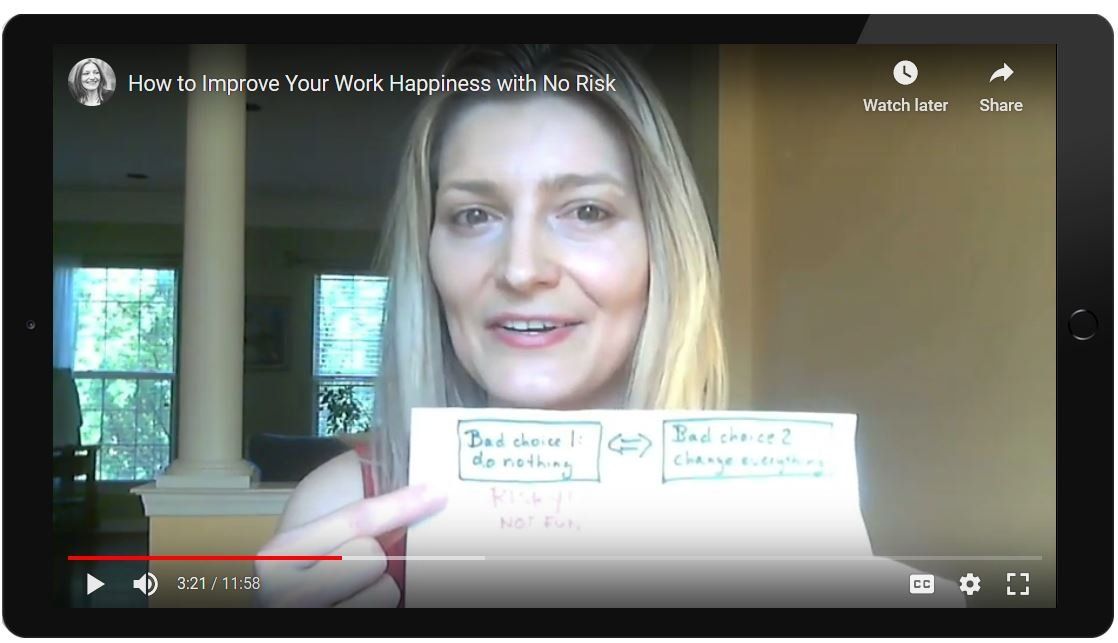Blog Post
Free Yourself From Negative Emotions in 3 Simple Steps
Jun 01, 2020

How to get from victim to sage mode, even when you don’t feel like it.
“I don’t want to be at the mercy of my emotions. I want to use them, to enjoy them, and to dominate them.” ― Oscar Wilde
I think many of us can relate to Oscar Wilde’s desire to have some control over his emotions, particularly the disruptive ones. And yet, the reality often looks very different.
For instance, I recently talked to a coaching client who was pretty upset about something that had happened.
My client, let’s call her Mary (not her real name), is a mindful and self-aware person who meditates. However, she just couldn’t let go of the negative emotions she was feeling about a particular negative incident.
If you’re like me, you’ve probably experienced the same thing at some point: despite wanting to get over our reaction to an event, we sometimes just can’t. We keep on cycling back to an intense, unpleasant emotion again and again and again. It's through that repetitiveness that negative emotions can become a big life problem.
That’s what Mary was going through when we talked. As she expressed her bewilderment about how hard it was to get rid of those unwanted feelings, I explained that we typically don’t manage to shift our emotional state in an instant.
For instance, I recently talked to a coaching client who was pretty upset about something that had happened.
My client, let’s call her Mary (not her real name), is a mindful and self-aware person who meditates. However, she just couldn’t let go of the negative emotions she was feeling about a particular negative incident.
If you’re like me, you’ve probably experienced the same thing at some point: despite wanting to get over our reaction to an event, we sometimes just can’t. We keep on cycling back to an intense, unpleasant emotion again and again and again. It's through that repetitiveness that negative emotions can become a big life problem.
That’s what Mary was going through when we talked. As she expressed her bewilderment about how hard it was to get rid of those unwanted feelings, I explained that we typically don’t manage to shift our emotional state in an instant.
The Stages of Emotional Release
What I have found works best when it comes to letting go of negative emotions is a multiple-step (or stage) process. I recently used this model myself after making an annoying mistake that led me to lose a number of files that I wasn’t able to recover.
By following these steps, I was able to remain surprisingly calm in the midst of my mishap, instead of continuing to beat myself up about something that I couldn’t undo anyway.
In that situation, I went through three distinct stages. The names I currently use for these stages are as follows:
The best analogy I have for this is water, which — as we all know — can exist in three different forms: solid, liquid, and gas.
When we’re stuck with an emotion, we experience it as solid and unmovable (just like snow). What we would like instead is for it to be almost unnoticeable, like gas. However, if we heat up snow over a fire, it first turns to liquid before it vaporizes.
Our emotions are similar in that each of the three stages I described above builds on the previous one, and we have to go through them in order.
When I made the mistake I just described, I wasn’t able to go from “Oh no, how could you?!” to “Well, this is a great learning opportunity” in an instant. Instead, I moved one step at a time.
Let’s look at these stages in more detail:
By following these steps, I was able to remain surprisingly calm in the midst of my mishap, instead of continuing to beat myself up about something that I couldn’t undo anyway.
In that situation, I went through three distinct stages. The names I currently use for these stages are as follows:
- (empowered) victim,
- analyst, and
- sage mode.
The best analogy I have for this is water, which — as we all know — can exist in three different forms: solid, liquid, and gas.
When we’re stuck with an emotion, we experience it as solid and unmovable (just like snow). What we would like instead is for it to be almost unnoticeable, like gas. However, if we heat up snow over a fire, it first turns to liquid before it vaporizes.
Our emotions are similar in that each of the three stages I described above builds on the previous one, and we have to go through them in order.
When I made the mistake I just described, I wasn’t able to go from “Oh no, how could you?!” to “Well, this is a great learning opportunity” in an instant. Instead, I moved one step at a time.
Let’s look at these stages in more detail:
1. Victim Stage
“I am not a victim of emotional conflicts. I am human.” — Marilyn Monroe
When something negative has happened to us, we typically first find ourselves in the victim stage. This is an emotional stage where people rant, rage, or express their annoyance about the incident that has happened.
We’re often told that we shouldn’t allow ourselves to “be a victim,” but that’s only partially true. Just because we’re temporarily in a victim state doesn’t mean that we’re a victim in our lives in general. It just means that we’re human.
The (empowered) victim stage is an important one, and we don’t do ourselves any favors in bypassing it in favor of supposedly more enlightened feelings.
It’s also worth noting that sometimes people really are victimized in terrible ways and that they have a right to call themselves whatever they want — whether that’s victim, survivor, or anything else.
Even with minor incidents, people typically need to feel heard and seen before they’re ready to move on, so prematurely telling them to get over themselves is neither helpful nor compassion. Of course, we also don’t want to do the opposite and remain in a victim state forever.
While it’s uncomfortable to be in this place, it’s also necessary to fully acknowledge to yourself (or to another person) how you’re feeling. By owning your feelings of hurt or anger, you can then move from disempowered victim to empowered victim.
In this stage, consider the following questions:
- What did you want that you didn’t get?
- How did it make you feel when you didn’t get it?
In my case, I felt annoyed at myself for acting too rashly, leading to the (unrecoverable) loss of some of my content. What I wanted from myself that I didn’t get was to pause for a moment before taking action.
2. Analyst Stage
“Analysis gave me great freedom of emotions and fantastic confidence. I felt I had served my time as a puppet.” — Hedy Lamarr
We’re now able to move onto the analyst stage. In contrast to the previous stage, this is a rational and logical stage where you try to understand why the other person (or yourself, if you’re mad at yourself) acted the way they did.
This also starts to liberate us from the intensity of the emotions we’re feeling.
Consider the following question:
In our hypothetical example, the person who flaked out on you might have simply gotten the date wrong. Or perhaps they were too overwhelmed with other things that happened and forgot about it. It probably wasn’t anything personal.
In my case, I made a mistake because I was tired and wasn’t at my best due to the Covid-19 situation, which was at a peak back then.
You’re ready to move out of the analyst stage when you feel some love and compassion towards the person you want to forgive.
3. The Sage Stage
“The gateways to wisdom and learning are always open, and more and more I am choosing to walk through them.” — Louise L. Hay
If you’ve made it this far, congratulations. You’ve come to the best part of the process! This is a proactive or even transcendental stage where you look for the learning opportunity in the experience.
Consider these questions:
- Where’s the gift in this?
- How could this help you improve your life?
In my case, the gift I got from this experience is that it helped me realize that I needed to share my content with people — and back it up. Everything I had shared with others was still there; it’s just the content I had kept for myself that was gone for good.
When you consider these questions, you might even be able to find some gratitude for the whole experience, since you were able to gain new insight and knowledge about yourself and others.
The Takeaway
The next time you’re upset about something, recall that it’s easiest to change emotions one step at a time instead of all at once.
Along the way, you’ll move from victim to analyst, to sage, learning something valuable from an otherwise problematic situation.
That’s what I did with my recent mishap, and I’m happy to report that this process worked just as well for Mary.
By following the steps I just described, you will be able to gain control over disruptive emotions, with the elegance of water.
After all, as the great Bruce Lee advised:
Along the way, you’ll move from victim to analyst, to sage, learning something valuable from an otherwise problematic situation.
That’s what I did with my recent mishap, and I’m happy to report that this process worked just as well for Mary.
By following the steps I just described, you will be able to gain control over disruptive emotions, with the elegance of water.
After all, as the great Bruce Lee advised:
“Be water my friend.”
Did you like this article?
Was it helpful for you?
Are you glad you read it?
May I help you some more?
I have created a free mini-meditation for you that can help you get from stressed to blessed in 5 minutes! If you'd like to check it out, just click on the button!
YES!
Was it helpful for you?
Are you glad you read it?
May I help you some more?
I have created a free mini-meditation for you that can help you get from stressed to blessed in 5 minutes! If you'd like to check it out, just click on the button!
Stay in touch:
Browse Blog Posts
By Louise
•
07 Mar, 2024
As you might have noticed, I recently decided to go by a different name ("Louise" instead of "Bere/Berenike"). My "new" name is actually my middle name and asking people to call me Louise has been really liberating for me. Basically, my name had been an ongoing source of subtle (and sometimes not-so-subtle) unhappiness and discomfort throughout my life. So, it feels great to have that issue resolved. :) If you are interested in reading more about my process, I have written a long post about changing my name on my blog here.
Copyright 2024, all rights reserved. Privacy Policy




